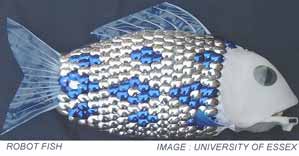Aquatic Robots
Although there is an increasing  interest in the study of aquatic robots, there are only a few successfully built aquatic robots. This is because of the challenging environment they work and also because electricity and electronics essentially do not like water. Making a robot to work in water generally ends up in undesirable failures. However if you are interested in building a robot to maneuver in a local pond or your swimming pool, then you are still in good hope given that building a robot to submerge less than 10mts is considerably easier. There are a few challenges you need to overcome before designing an aquatic robot.
interest in the study of aquatic robots, there are only a few successfully built aquatic robots. This is because of the challenging environment they work and also because electricity and electronics essentially do not like water. Making a robot to work in water generally ends up in undesirable failures. However if you are interested in building a robot to maneuver in a local pond or your swimming pool, then you are still in good hope given that building a robot to submerge less than 10mts is considerably easier. There are a few challenges you need to overcome before designing an aquatic robot.
The first challenge in creating an aquatic robot is to make all the electronics waterproof. There are many ways by which electronics can be made waterproof. Some of the basic ideas are listed below:
- Enclosing all the circuits and electronics in an air-tight container
- Enclosing the circuits in oil filled containers which resists water inflow
- Using hot-glue all over the circuits and then submerging them
Differential drive technique works best on these aquatic robots and driving force can be tails, fins, thrusters, wings, thrusters, paddles, paddle wheels, air pumps etc., based on your robot design.
Aquatic robots include robots that sail, submerge or crawl under water.
Robot boat
Robot boats float over water and are not designed to submerge in water. They can be either autonomous or remotely controlled. This is the easiest form of aquatic robot as it does not involve complex waterproofing of electronics as most of electronics can still stay away from water.
Swimming robots / Submarines
Have you ever seen a robot fish? These can be categorized as swimming robots. Swimming robots are fin driven although there are submarine versions which dive deep into water and propel themselves from one place to another using wings, propellers, etc. These underwater robots are generally controlled with little or no intelligence built inside them.
Underwater Crawling robots
Under water Crawling robots are marine version of land based robots. These robots either roll on wheels or walk under water; if waterproofing is taken care, these robots can be easily designed and built. The concept of land based robots still holds good for underwater crawling, rolling or walking robots.
Advantages and Disadvantages of aquatic robots
Some of the advantages of aquatic robots are:
- Vast unexplored field of robotics
- Each design is assured to be unique
- Wide area of opportunities as most part of our world is water
- Too many opportunities in commercial applications
- Testing environment can be anything from a local pond, bucket of water or a swimming pool
With opportunities come challenges. Some of the major hindrances while building aquatic robots are:
- Water proofing: Electronics hate water and not water proofing the circuitry resulting in shorting your entire circuit
- Deeper depths require more sophisticated designs and considerable research
- Very less number of aquatic robots would mean less support and minimal available resources
- Not all land based sensors work in the same way in water
- Density and weight of robot significantly affects the working of marine based robots, which can be easily ignored in land based robots
Undiscovered challenges and unexpected guests should be handled meticulously :)
Do you have anything to say?
Visit the Forum to discuss, learn and share anything related to robotics and electronics !!








